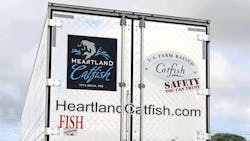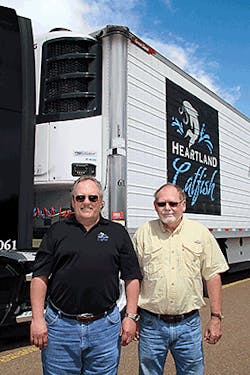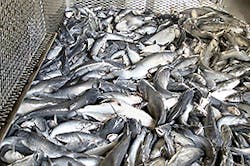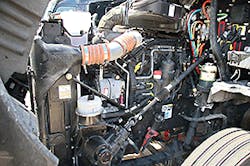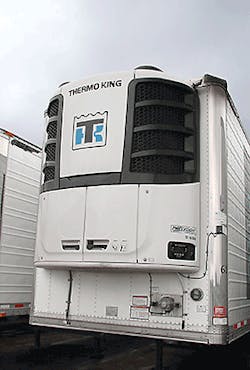Latest tractor, reefer trailer specs help Heartland Catfish handle customer demand
ALL 23 tractors in the Heartland Catfish Company fleet were replaced over the past two years. In addition, the company’s refrigerated trailer fleet is being updated on a regular schedule.
It’s all part of the company’s effort to ensure that customers receive their shipments of fresh and frozen catfish on schedule and in the best possible condition. The relatively small company fleet hauls 65% of the catfish processed at Heartland’s 135,000-sq-ft plant in Itta Bena, Mississippi. Customer-arranged transportation handles the remaining shipments.
“We process our catfish in a state-of-the-art plant, and we haul the fish in a state-of-the-art fleet,” says James Sorrels, Heartland Catfish transportation logistics director. “We believe we are running some of the most efficient tractors on the road today, and we are running what we believe is one of the best refrigerated trailers on the road today. We also run some of the latest transport refrigeration technology.
“Taking proper care of each shipment is a critical focus for us, and we don’t take shortcuts. Temperature management and trailer sanitation are especially important. Trailer interiors are pressure washed with detergent and steamed out after every load. We believe we already have the equipment and procedures in place to meet the Sanitary Transportation of Food rules that begin to take effect this year.”
Steady consumer demand for catfish keeps the Heartland operation running hard. While distribution operations are concentrated in the southern United States, the company fleet serves customers across the country. Customers include fish distributors and foodservice suppliers as well as large restaurant chains, such as Cracker Barrel.
Evolving business
The business that evolved into Heartland Catfish dates back to the mid-1970s when William Tackett, his son Jim Tackett, and his son-in-law Joe Walker began raising catfish on 80 acres in the western part of Leflore County, near Schlater, Mississippi. Growing out of that initial 80 acres was Tackett Fish Farms, which is today the largest farm-raised catfish operation in the United States, according to Heartland Catfish officials.
Throughout the 1980s and 1990s, Tackett Fish Farm sold its live catfish to various cooperative processing plants in the area, but the owners began to see the benefits of building their own processing plant. Realizing that other processors were already well established in the marketplace, they knew they had to find ways to stand out from the competition. To achieve that objective, their company had to produce the highest quality catfish products and provide the best customer service at the best value.
The 35,000-square-foot plant they opened in 1996 in Itta Bena merged the best industry standards for filleting with the latest technology for grading products and monitoring the process flow. In order to have the safest and highest quality product, the plant was designed with two key elements in mind: temperature control and sanitation. In every area of the plant, temperatures are monitored and controlled by computer software capable of warning staff members and management if temperatures reach critical levels that are outside established standards. On the sanitation side, a direct-fired water heater provides sanitation crews with on-demand water at 140°F for all cleanup and sanitation operations.
Computerized grading and weighing is another critical factor. Live fish are graded individually and each fish is sent to the processing line that will most effectively use that fish. Fillets are individually weighed and graded based on weight to ensure that they meet Heartland’s specifications. Product also is packed on computerized scales to ensure that customers receive shipments that are consistent and accurate.
With its 400 employees, the Itta Bena plant can process up to 360,000 pounds of catfish a day. A spiral blast freezer is used to Individually Quick Freeze fillets at a rate of 19,000 pounds per hour. It takes just 45 minutes for each catfish to move through the production process.
In addition to the Itta Bena plant, Heartland acquired the assets of Southern Pride Catfish in Greensboro, Alabama, 2008 and currently uses that facility as a retail packing operation and a cold storage facility.
Transportation management
Transportation management has been a critical concern since the Heartland plant opened in 1996. For the first couple of years, trucking was outsourced. The company began running its own trucks in 1998.
“Heartland tried using a for-hire carrier at first, but it just didn’t work well,” Sorrels says. “We have high service requirements for the fresh fish shipments, and it is critical to control the transportation operation. We also need flexibility in the system. We’ve found that having our own fleet is the best option.
All of the catfish—fresh and frozen—is transported by truck, and the process is managed with a distribution application developed in house. The application builds shipping routes that are designed to keep Heartland’s refrigerated transports moving.
Most orders come in a day prior to shipment, especially the fresh catfish. A majority of the loads hauled by Heartland’s fleet are scheduled for multi-drop, with the average number of deliveries being four. Both fresh and frozen catfish are hauled on the trailers, and refrigeration units typically are set for 20°F.
Typical runs are out and back for the Heartland fleet, and drivers could be out up to three days each week. In many cases, drivers serve the same customers, week in and week out.
“We have weekly shipments to New Orleans (Louisiana) and twice a week to Houston and Dallas (Texas), Los Angeles (California), and Denver (Colorado),” Sorrels says. “Our longest hauls are 2,764 miles to points in the Northeast, and we have occasional shipments to the Pacific Northwest.”
While a majority of loads are delivered to facilities with loading docks, hand deliveries are required for some of the smaller customers. “Probably 99% of our loads are dropped at a loading dock, and we have very little driver unloading,” Sorrels says. “We use lumpers as needed. For worker comp reasons, we don’t want our drivers to do much of the unloading.”
Backhaul activity
Once the load is delivered and the trailer is washed out, the Heartland driver is ready for the return trip to Itta Bena. Most of the time, a backhaul will have been pre-arranged. Backhaul cargoes have included produce, meat, and flour.
“Ideally, our driver will have taken his sleeper time before making his delivery,” Sorrels says. “We want him to have available hours so he can start his return trip as soon as the backhaul is loaded.
“We don’t want our drivers or our trucks just sitting. It’s not fair to make the driver wait for a backhaul. A driver is happiest when he is on the road, and a happy driver is a safer driver.”
The fleet management strategy seems to be working well. With the exception of retirements, Heartland has virtually no driver turnover. In fact, Dennis Jones, the first driver hired when the company launched its private fleet is still hauling loads every week. Known as “Pops” by Heartland management and his fellow drivers, Jones has 40 years of truck driving under his belt.
Jones had taken a four-year break from truck driving to spend more time with his young children and had gone to work for Tackett Fish Farms. When Heartland set up its own refrigerated distribution fleet, he decided the time had come to get back on the road.
When replacements are needed, the company hires only experienced truck drivers with at least five years of over-the-road experience. Most have a lot more than that.
For many years, Heartland provided its drivers with owner-operator-style long-nosed Kenworth W900s. “One of our owners used to drive trucks and he had affection for the long-nose cowboy truck with lots of chrome,” Sorrels says. “They’re certainly a beautiful truck and we ran those until two years ago when we made the corporate decision to be more efficient. What we gave up in nostalgia has more than paid off in reducing costs.”
The move toward greater fuel efficiency started with road tests of Kenworth’s T680 and Freightliner’s Cascadia. Sorrels and Jones were the drivers on the two-day test trips that took them on a circuit to Houston, Dallas, and Longview, Texas that Jones has been making twice a week for the past 11 years.
“Going into the evaluation, we had an open mind,” Sorrels says. “Our attitude was ‘may the best machine win.’ Both were good, comfortable trucks with similar specifications. Pops and I split driving duties, and the first thing we noticed was the 13-liter engines (rated at 455 horsepower for the T680 and 475 horsepower for the Cascadia). It had as much power and torque as our 15-liter engines in the W900s. So, we were happy with the power.”
At the end of the testing, the two men determined that the T680 was the clear winner. “What really swayed us was the quiet T680 cab and the visibility out the front and sides,” Sorrels says.
Jones adds simply: “Whoever designed this truck, sure knew what they were doing. I didn’t think they could build a truck that could drive like this. The other truck we drove was like your standard fleet truck. The T680 is a driver’s truck. I like everything about it—including how much room there is between the seats, all the headroom, and how the sleeper is laid out. There is plenty of storage. It’s just a really comfortable truck. If I had to go out on my own, this is the truck I’d buy for myself.”
Heartland bought the new tractors in two batches, one in 2013 and the other in 2014. Specified with Paccar’s MX-13 engine and Eaton Fuller’s UltraShift PLUS automated transmission, the aerodynamically styled tractors are delivering excellent performance. They have brought a fuel economy gain of 2.3 miles per gallon over previous long-nose W900s, which means a fuel savings of more than $2,000, per truck, per month. That’s more than a $44,000 monthly savings in the cost of fuel for the fleet. The tractors are configured to run a maximum of 70 miles per hour.
Fuel economy wasn’t the only consideration when the new tractors were selected. “Our T680s aren’t lacking for amenities,” Sorrels says. “We spec’d them out with the Diamond VIT package with refrigerator, TV package, rotating table, plus space for a microwave oven. All the T680s have 76-inch sleepers, except for two with 52-inch mid-roof sleepers. The mid-roof sleepers are needed so the trucks can go under an overhead water supply that is used to fill the compartment on trailers used to transport live catfish to the processing plant.”
The tractors also have Thermo King TriPac auxiliary power units. Fleet management systems in the cab include Omnitracs on-board computers and PrePass transponders that allow the trucks to bypass designated weigh stations and port-of-entry facilities.
“We will shift to e-logs in the near future,” Sorrels says.
Refrigerated trailers
Thermo King refrigeration units are standard for the Heartland fleet. The newest purchases were for Precedent C-600 units.
Great Dane is the primary supplier of the high-cube 53-foot reefers that Heartland prefers to run. Trailers—as well as tractors—are spec’d to enable a 44,500-lb maximum gross payload.
Currently, the standard refrigerated trailer in the Heartland fleet is based on Great Dane’s Everest TL model. Exterior wall material is .050 corrugated aluminum sheet and Great Dane’s PunctureGuard interior liner that has three times the peel strength of other lining materials. Flooring is corrugated extruded aluminum. The fleet specifies 22-inch-high aluminum scuff rails.
“We have significantly reduced interior trailer damage with the PunctureGuard liner and the 22-inch scuff rails,” Sorrels says. “In fact, we haven’t seen any damage since making those spec changes.”
Foam-in-place insulation is used throughout the trailer. The nose has 3.5 inches of insulation and there are 2.9 inches in the roof and 2.5 inches in the sidewalls and floor.
TrailerBlade side skirts from Strehl USA are very durable and are built to stay on the trailer, according to Sorrels. Trailer running gear includes Hendrickson’s Vantraax air suspension/axle system, Hendrickson’s Tiremaax Pro tire inflation system, Alcoa aluminum disc wheels, and Bridgestone tires.
With all new tractors in the fleet and with a steady upgrade effort underway for refrigerated trailers, the company has made changes in its replacement schedule. Tractors are now on a 42-month schedule, which means they will have run roughly half a million miles. Management is considering decreasing the current seven-to-10-year trailer replacement cycle to seven to eight years.
“We believe we’ll see better trade values with the reduced replacement cycles,” Sorrels says. “In addition, technology keeps changing for trucks and refrigeration systems. Finally, trailer insulation does degrade over time. We want to make sure we serve our customers with the most efficient, reliable transport equipment.” ♦
About the Author
Charles Wilson
Charles E. Wilson has spent more than 30 years covering the transportation industry throughout North, South, and Central America. He is editor of Bulk Transporter and editorial director of Refrigerated Transporter. Prior to that, Wilson was managing editor of Bulk Transporter and Refrigerated Transporter and associate editor of Trailer/Body Builders. Before joining the three publications in Houston TX, he wrote for various food industry trade publications in other parts of the country. Wilson has a bachelor's degree in journalism from the University of Kansas and served three years in the U.S. Army.
